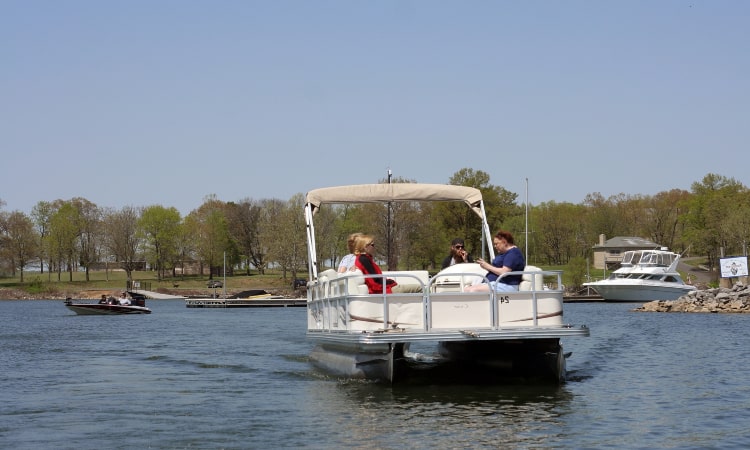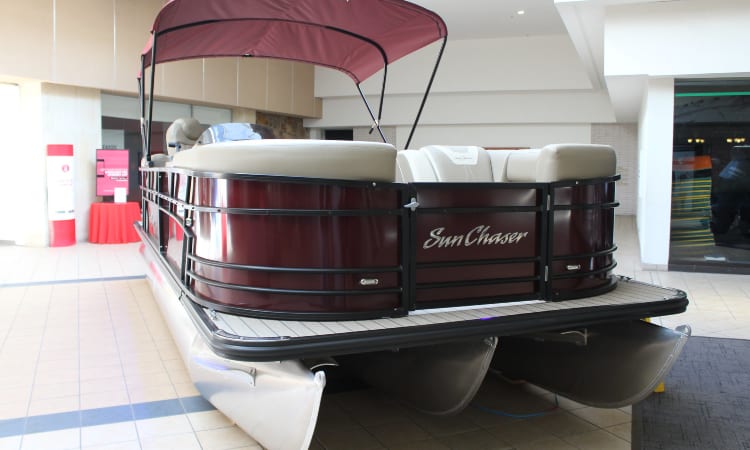Shopping for a pontoon boat isn’t an easy-peasy task. After determining the size, style, and budget, you’ll be left with a harder variable: the engine horsepower. So, what size motor do you need for a pontoon boat?
For 20′, 21′, and 22′ pontoon boats, you should have at minimum a 90HP motor. For 23′, 24, and 25′ pontoon boats, I don’t recommend going below 150HP. The “all-around” performance can be achieved by a 175HP motor. If you want the best of the best, go for a 200HP motor.
Although the size of the motor matters, there are other factors that determine your pontoon speed. Curious? Let’s find out what they are!
By the way, as an Amazon Associate, I earn when buying qualified products through links on my site.

What’s The Ideal Motor Size For a Pontoon Boat
You should get a pontoon motor that is at least 90HP for a pontoon boat length up to 22ft. This size of motor will give you a 22MPH top speed (or more) which works for general cruising and fishing.
I looked at over 70 boats and their top speeds with different sizes and I cobbled together this in a table for you. Please take the data with a grain of salt because these speeds were self-reported. People exaggerate, forget details…, also, not every pitometer or GPS is very accurate with speed and the speeds may be off by a few MPH.
Also, top speed can be very complex. Weather, how much fuel you have in the tank, how many people you have on board, how heavy those people are, whether your bimini is down or up, the pitch of your motor, its height, lifting strakes–even the temperature of the water! This is a great starting point though to give you an idea of what speeds people can get with different horsepower.
| Boat Length (feet) | 25 HP | 50 HP | 60 HP | 70 HP | 75 HP | 90 HP | 115 HP | 135 HP | 150 HP | 200 HP | 225 HP | 250 HP | 300 HP | 350 HP |
| 16 | 14 | |||||||||||||
| 18 | 10 | 21 | ||||||||||||
| 20 | 17.25 | 23 | 24.5 | 24.75 | 26 | |||||||||
| 21 | 20 | 30.75 | 30 | 31.3 | 38 | |||||||||
| 22 | 22 | 29 | 27.9 | 38 | ||||||||||
| 23 | 38 | 46.5 | 51 | 44.5 | ||||||||||
| 24 | 21.5 | 22.9 | 40 | |||||||||||
| 25 | 20 | 27 | 37 | 41.5 | 46 | |||||||||
| 27 | 45 | |||||||||||||
| 29 | 47.8 |
- The most common motor power for most pontoon boats was 90HP
- The most common pontoon boat length was 21 feet
- The average top speed for all pontoon boats was 30.4 MPH
By the way… are you wondering how much pontoon boat you can get for your money these days? Check out our Pontoon Boat Prices Guide, here
What Size Motor For A 20′ Pontoon Boat?
If you want to get at around 20MPH-24MPH, you can get by with a 60 HP motor. If you want speeds around 24-29 MPH or more, then you should go with a 90HP motor.
What Size Motor For A 21′ Pontoon Boat?
You should consider a 90 HP motor for a 21′ pontoon boat if you want speeds around 24-29 MPH or more (that is if you don’t have any other adjustments such as lifting strakes, etc).
From my data, there were some people who got top speeds of around 35-38 with a 90HP motor with 21′ pontoon boats!
However! There’s a big caveat here: Many of these high performing 21 foot boats had lifting strakes, which help adjust the boat so it’s not plowing into the water and wasting all that power.
So, the takeaway is that if you aren’t planning on doing any modifications to your boat to enhance speed, then you should count on around 24-29 MPH without any other adjustments.
What Size Motor For A 22′ Pontoon Boat?
The bare minimum size motor for a 22′ boat is 90HP. You might be able to get around 25 MPH but you should really consider a 115HP motor.
Most pontoon boat owners with a 22′ pontoon boat got around 29MPH with a 115HP motor.
That being said, if you are satisfied with 22MPH, than a 90HP motor has worked for many.
What Size Motor For a 24′ Pontoon Boat?
If you’re considering a 24 foot pontoon boat you should get a 115 HP motor if you want to get around 24-29MPH.
If you are trying to get greater than 30MPH speeds than you are looking into the 150HP+ territory with lifting strakes.
The thing about the data behind this is that with bigger boats people are carrying more people. A single person can change the top speed by .5MPH or more
What Size Motor For a 25′ Pontoon Boat?
The minimum motor size for a 25′ pontoon boat is 150 HP, but it’s not a bad idea to go for 200 or 225. You can expect top speeds of around 30 MPH with a 150 HP on a 24′ pontoon boat.
Technical Factors That Affect the Pontoon Speed
As I said in the intro, the motor size is the first of many factors that may directly affect your pontoon’s speed.
Boat Weight And Length
It doesn’t take an expert to understand that the longer the boat, the heavier it’ll be. Obviously, as the boat gets heavier, you’ll need to get a larger outboard motor to compensate for the added drag.
20-Footers and Shorter
For 16-foot boats, getting a 25HP motor should do the trick. In calm water, you can expect to ride at about 5 mph.
Any boat longer than 20 feet shouldn’t have less than a 115HP motor. This doesn’t necessarily mean that smaller engines will suck. But it’s a good idea to consider this as a baseline horsepower to guarantee an acceptable resale value.
24-Footers and Longer
24-feet boats carrying an average of 4 people can operate smoothly with a 150HP motor. You won’t break any speed records, but you’ll go at comfortable speeds for tubing while having a crew on board.
Ramp it up to 175HP if you’re likely to cruise around with a full crew of 8 to 10 people.
If budget isn’t an issue, the bigger will always be better. A 200HP motor will give you the best performance with your boat fully loaded with crew.
Tube Diameter
Old pontoons used to come with 19, 21, and 23-inch tubes. Nowadays, it’s pretty rare to see tubes smaller than 23”.
And of course, the wider you go, the more lift you’ll have. That way, your motor won’t have to work as hard. For 24-foot boats, 25” tubes would work just fine. If your budget allows, consider 27-inch tubes.
Tube Number
This is where things get a bit controversial. Some boaters believe that tri-toons — boats that have a third tube — float easier on the water, which allows for less drag and higher speeds.
On the other hand, old-school boaters explain that the added weight of the third tube will do more harm than good.
The truth is, this depends on the tube placement. Usually, the additional tube sits below the two tubes on the sides. This way, it can displace enough water to create a larger lift without weighing you down.
What’s more, tri-toons are way more stable than conventional pontoons. You can equip them with 200+HP without worrying about that annoying lean that happens while turning.
From my data, I found that the tritoons, in general, had higher top speeds than 2-tube boats.
Lifting Strakes
Getting tubes with built-in lifting strakes (if you don’t know what lifting strakes are, read our article, here) can allow you to enjoy the full potential of your outboard motor.
If you’re unfamiliar, these strakes come as small metal projections welded onto the tubes. When you drive, these strakes will displace the water, allowing the boat to get up on a plane rather than plow or lumber through the water.
With the front third lifted off the surface, your boat will be able to ride faster and smoother. And owing to the decreased drag, you’ll also end up saving some fuel.
Installation
Technically speaking, the lifting strakes can be welded to your existing tubes. However, you’ll need to find an expert who can masterfully adjust the angles and height. Otherwise, the strakes won’t generate the required lift, or worse, give you annoyingly bumpy rides.
That said, I always recommend getting new tubes with pre-installed strakes. Getting a whole new boat is even better since the overall design will be optimized to get up on a plane.

When in Doubt, Ask a Local Dealer
If the previous details seemed too complicated, no worries! It’s always a good idea to consult your nearest dealer.
It’s important to be specific about your needs. Tell the dealer about how many people will often ride on board. Then, explain the nature of your intended activities: Are you thinking about pulling wakeboarders, skiers, or tubers? Or will you just cruise around with friends and family?
The dealer should be able to suggest a suitable motor that will live up to your needs. Even if they ended up upselling an unnecessarily-powerful model, it’ll maintain its resale value for years.
Don’t Forget to Bring Up the Locale
If you’re planning to ride the boat inside the local waters, you’ll be in the clear. The dealer will typically know what works and what doesn’t, without needing to discuss it with you.
However, if you don’t want to limit yourself, you’ll need to roughly explain your planned locale since this can directly impact the horsepower choice. For instance, rivers and coasts will require more robust motors when compared to lakes and impoundments.
Bonus: Tips to Get the Best Out of Your Motor
In the following section, I’ll introduce a couple of minor tips that can have a more or less significant impact on the pontoon’s speed.
Engine Mounting Height
Just like any other boat, pontoons have a sweet spot in which you should mount the outboard motor.
The goal is to get the anti-ventilation plate below the water surface to prevent propeller ventilation. You don’t want to push it down too far, though. Otherwise, the lower unit, aka gearbox, would create an excessive drag.
While adjusting the height, try to mimic the load distribution that your boat will likely bear.
For instance, let’s assume you’ll go fishing with 4-5 friends. If they sit toward the bow, this may raise the stern enough to cause propeller ventilation. In that case, you’ll want to position the motor a bit lower than average. It’d take a lot of experimenting on your part, but the results will be worth it.
Don’t Fill the Tank
Unless you’re planning to pull all-nighters with your friends, don’t be tempted to fill up your tank.
On average, gas weighs 8 pounds per gallon. So if you filled a 25-gallon tank only to its middle, you’ll spare about 100 pounds. It may seem like a small difference, but it can actually do wonders for the boat lift and speed.
Conclusion
Based on the previous information, most 24-foot pontoon boats would do just fine with a 150HP motor. The best performance, however, can be achieved with a 175HP or, better yet, a 200HP outboard motor.
But as I explained, answering the question, “what size motor for a 24-foot pontoon boat?” isn’t only about horsepower. Things like the tube length, number, and lifting strakes can have a non-negligible effect.
Remember, if this seems like too much to handle, reaching out to a local dealer is also a great option.
